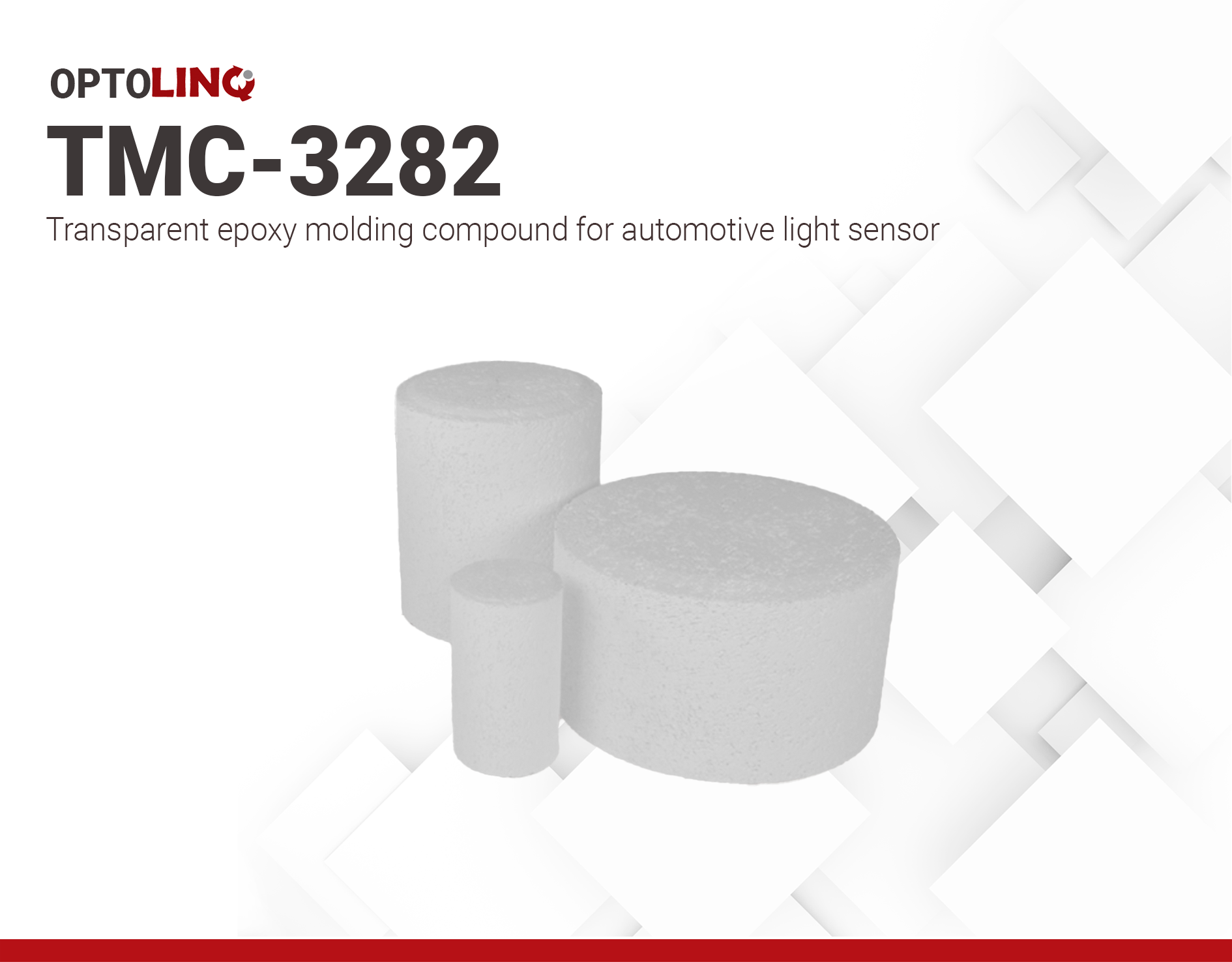OPTOLINQ TMC-3282 | Transparent Mold Compound
- Exceptional moldability with long spiral flow
- Excellent performance at high temperature and high humidity conditions
- Excellent adhesion and low stress
Product Description
OPTOLINQ TMC-3282 is a high performance optically clear epoxy molding compound specifically designed for the encapsulation of optoelectronic packages for automotive applications such as ambient light sensors and detectors. With its high spiral flow, it ensures precise and intricate molding.
OPTOLINQ TMC-3282 offers low moisture sensitivity maintaining performance even in high temperature and humidity conditions. TMC-3282 stands out with its superior moldability and reliability, ensuring good quality and precision in optoelectronic device molding.
Key Features:
- Low inner stress, strong adhesion and low moisture sensitivity
- Superior process characteristics and high reliability
- Durable Clarity
Technical Specifications
| General Properties | |||||||||
| Color Color The color | Transparent | ||||||||
| Specific Gravity Specific Gravity Specific gravity (SG) is the ratio of the density of a substance to the density of a reference substance; equivalently, it is the ratio of the mass of a substance to the mass of a reference substance for the same given volume. For liquids, the reference substance is almost always water (1), while for gases, it is air (1.18) at room temperature. Specific gravity is unitless. | 1.24±3 | ||||||||
| |||||||||
| Physical Properties | |||||||||
| Spiral Flow @ 175°C | 70-180 cm | ||||||||
| Mechanical Properties | |||||||||
| |||||||||
| |||||||||
| |||||||||
| Molded Shrinkage | 1.5 % | ||||||||
| Thermal Properties | |||||||||
| |||||||||
| |||||||||
| Glass Transition Temperature (Tg) Glass Transition Temperature (Tg) The glass transition temperature for organic adhesives is a temperature region where the polymers change from glassy and brittle to soft and rubbery. Increasing the temperature further continues the softening process as the viscosity drops too. Temperatures between the glass transition temperature and below the decomposition point of the adhesive are the best region for bonding. The glass-transition temperature Tg of a material characterizes the range of temperatures over which this glass transition occurs. | >125 °C | ||||||||
| Curing Conditions | |||||||||
| |||||||||
| |||||||||
| Transfer Pressure | 5.5±2.5 kg/cm2 | ||||||||
| Transfer Time | 50±10 s | ||||||||
Additional Information
Processing Instructions
Before use, allow TMC-3282 to reach room temperature (20±5 °C, 40±15% RH) for a minimum of 24 hours, ensuring the bag remains unopened to prevent moisture contamination.
For TMC-3282, preheating can be performed using standard RF equipment. Preheating must be done slowly to achieve uniform temperature.
Apply an outer releasing agent, such as silicones or fluorinated compounds, to the mold surface to facilitate easy release from the mold dies. Different curing conditions should be used depending on the mold design package, kind, and device type.
Prior to molding with TMC-3282 or any new material, the mold should be cleaned thoroughly. To prepare the mold, the initial three shots should be cured for 5–10 minutes. After this initial preparation period, you can reduce the curing time to a level that provides sufficient hot hardness for effective release.
Please note that the provided information is based on available data and typical conditions. For specific applications and detailed test results, refer to the actual test data and conduct appropriate certifications.
Storage and Handling
OPTOLINQ TMC-3282 is available in pressed pellets in a wide range of sizes to meet specific customer needs. To ensure product integrity, keep it away from oxidizing materials. For long-term storage, maintain a cold environment, ideally at –10°C or lower. The shelf life under this condition is 6 months.




